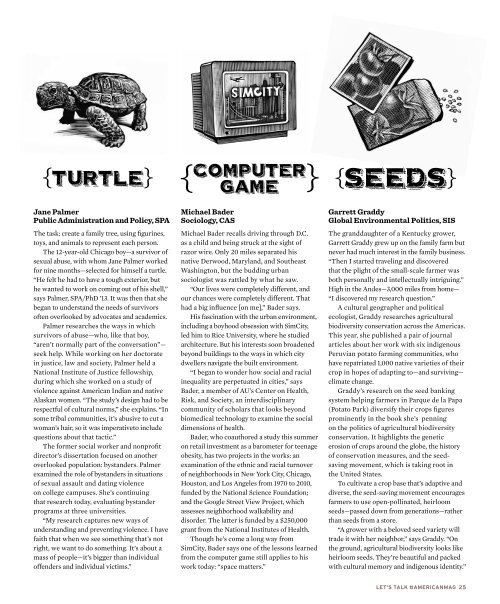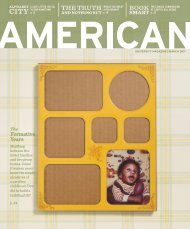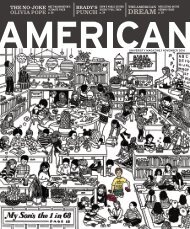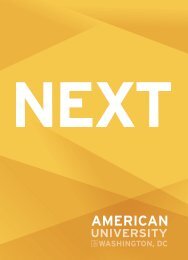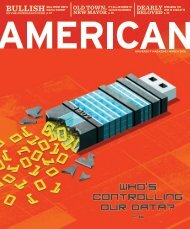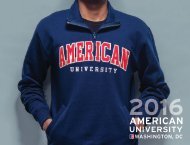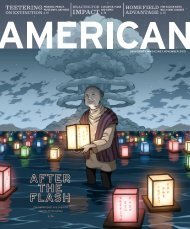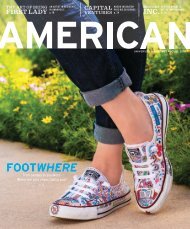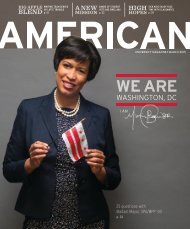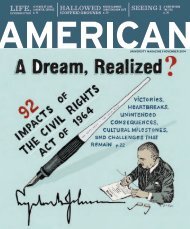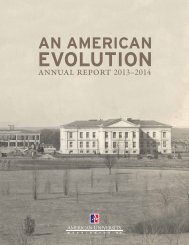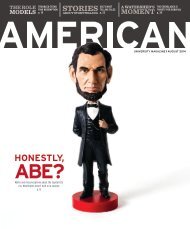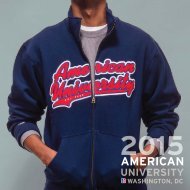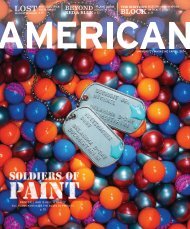American Magazine, Nov. 2013
The flagship publication of American University. This magazine offers a lively look at what AU was and is, and where it's going. It's a forum where alumni and friends can connect and engage with the university.
The flagship publication of American University. This magazine offers a lively look at what AU was and is, and where it's going. It's a forum where alumni and friends can connect and engage with the university.
You also want an ePaper? Increase the reach of your titles
YUMPU automatically turns print PDFs into web optimized ePapers that Google loves.
Jane Palmer<br />
Public Administration and Policy, SPA<br />
The task: create a family tree, using figurines,<br />
toys, and animals to represent each person.<br />
The 12-year-old Chicago boy—a survivor of<br />
sexual abuse, with whom Jane Palmer worked<br />
for nine months—selected for himself a turtle.<br />
“He felt he had to have a tough exterior, but<br />
he wanted to work on coming out of his shell,”<br />
says Palmer, SPA/PhD ’13. It was then that she<br />
began to understand the needs of survivors<br />
often overlooked by advocates and academics.<br />
Palmer researches the ways in which<br />
survivors of abuse—who, like that boy,<br />
“aren’t normally part of the conversation”—<br />
seek help. While working on her doctorate<br />
in justice, law and society, Palmer held a<br />
National Institute of Justice fellowship,<br />
during which she worked on a study of<br />
violence against <strong>American</strong> Indian and native<br />
Alaskan women. “The study’s design had to be<br />
respectful of cultural norms,” she explains. “In<br />
some tribal communities, it’s abusive to cut a<br />
woman’s hair, so it was imperativeto include<br />
questions about that tactic.”<br />
The former social worker and nonprofit<br />
director’s dissertation focused on another<br />
overlooked population: bystanders. Palmer<br />
examined the role of bystanders in situations<br />
of sexual assault and dating violence<br />
on college campuses. She’s continuing<br />
that research today, evaluating bystander<br />
programs at three universities.<br />
“My research captures new ways of<br />
understanding and preventing violence. I have<br />
faith that when we see something that’s not<br />
right, we want to do something. It’s about a<br />
mass of people—it’s bigger than individual<br />
offenders and individual victims.”<br />
Michael Bader<br />
Sociology, CAS<br />
Michael Bader recalls driving through D.C.<br />
as a child and being struck at the sight of<br />
razor wire. Only 20 miles separated his<br />
native Derwood, Maryland, and Southeast<br />
Washington, but the budding urban<br />
sociologist was rattled by what he saw.<br />
“Our lives were completely different, and<br />
our chances were completely different. That<br />
had a big influence [on me],” Bader says.<br />
His fascination with the urban environment,<br />
including a boyhood obsession with SimCity,<br />
led him to Rice University, where he studied<br />
architecture. But his interests soon broadened<br />
beyond buildings to the ways in which city<br />
dwellers navigate the built environment.<br />
“I began to wonder how social and racial<br />
inequality are perpetuated in cities,” says<br />
Bader, a member of AU’s Center on Health,<br />
Risk, and Society, an interdisciplinary<br />
community of scholars that looks beyond<br />
biomedical technology to examine the social<br />
dimensions of health.<br />
Bader, who coauthored a study this summer<br />
on retail investment as a barometer for teenage<br />
obesity, has two projects in the works: an<br />
examination of the ethnic and racial turnover<br />
of neighborhoods in New York City, Chicago,<br />
Houston, and Los Angeles from 1970 to 2010,<br />
funded by the National Science Foundation;<br />
and the Google Street View Project, which<br />
assesses neighborhood walkability and<br />
disorder. The latter is funded by a $250,000<br />
grant from the National Institutes of Health.<br />
Though he’s come a long way from<br />
SimCity, Bader says one of the lessons learned<br />
from the computer game still applies to his<br />
work today: “space matters.”<br />
Garrett Graddy<br />
Global Environmental Politics, SIS<br />
The granddaughter of a Kentucky grower,<br />
Garrett Graddy grew up on the family farm but<br />
never had much interest in the family business.<br />
“Then I started traveling and discovered<br />
that the plight of the small-scale farmer was<br />
both personally and intellectually intriguing.”<br />
High in the Andes—3,000 miles from home—<br />
“I discovered my research question.”<br />
A cultural geographer and political<br />
ecologist, Graddy researches agricultural<br />
biodiversity conservation across the Americas.<br />
This year, she published a pair of journal<br />
articles about her work with six indigenous<br />
Peruvian potato farming communities, who<br />
have repatriated 1,000 native varieties of their<br />
crop in hopes of adapting to—and surviving—<br />
climate change.<br />
Graddy’s research on the seed banking<br />
system helping farmers in Parque de la Papa<br />
(Potato Park) diversify their crops figures<br />
prominently in the book she’s penning<br />
on the politics of agricultural biodiversity<br />
conservation. It highlights the genetic<br />
erosion of crops around the globe, the history<br />
of conservation measures, and the seedsaving<br />
movement, which is taking root in<br />
the United States.<br />
To cultivate a crop base that’s adaptive and<br />
diverse, the seed-saving movement encourages<br />
farmers to use open-pollinated, heirloom<br />
seeds—passed down from generations—rather<br />
than seeds from a store.<br />
“A grower with a beloved seed variety will<br />
trade it with her neighbor,” says Graddy. “On<br />
the ground, agricultural biodiversity looks like<br />
heirloom seeds. They’re beautiful and packed<br />
with cultural memory and indigenous identity.”<br />
Let’s talk #americanmag 25


